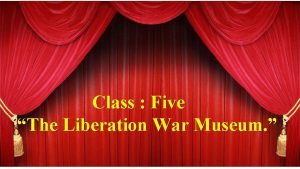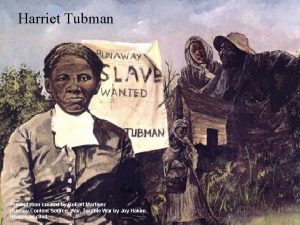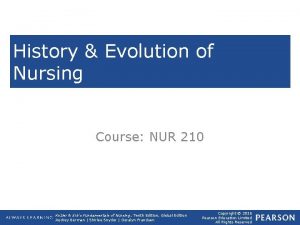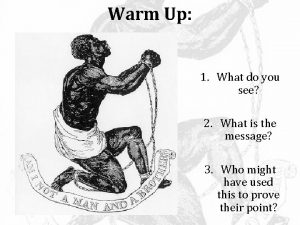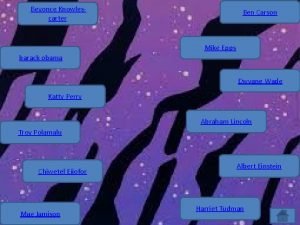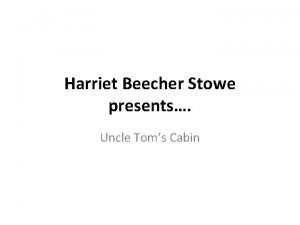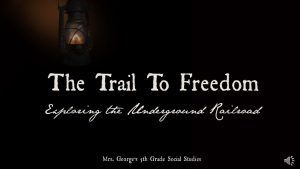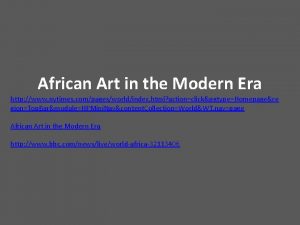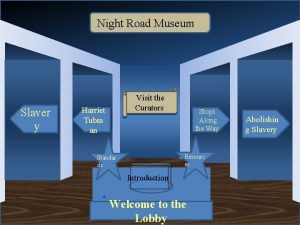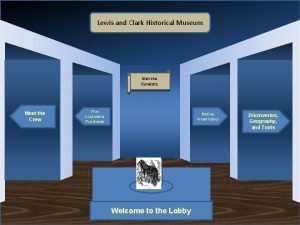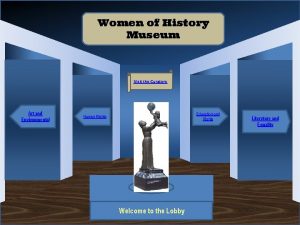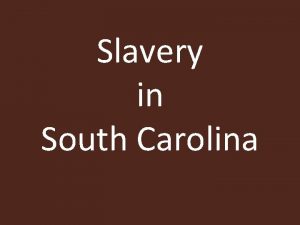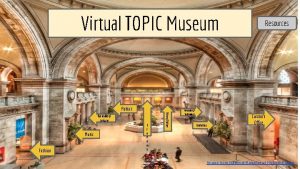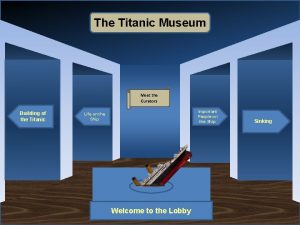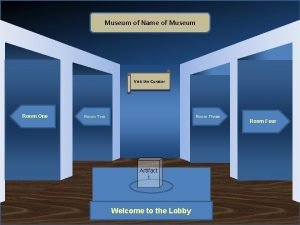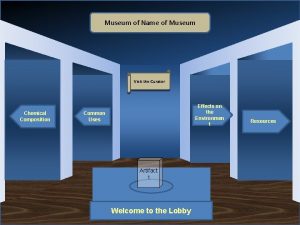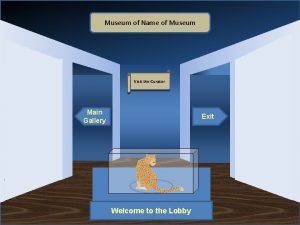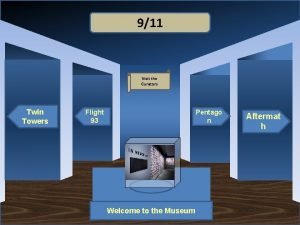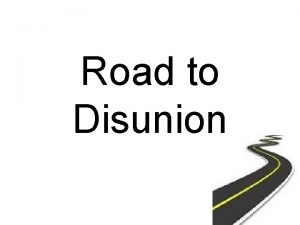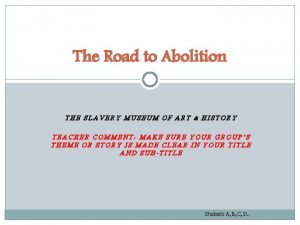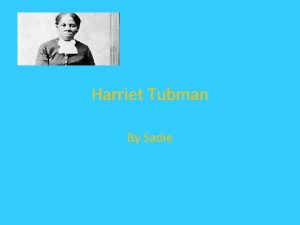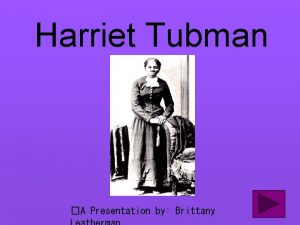Night Road Museum Slavery Visit the Curators Harriet






















- Slides: 22

Night Road Museum Slavery Visit the Curators Harriet Tubma n Stops Along the Way Resources Standar ds Introduction. Museum Entrance Welcome to the Lobby Abolishin g Slavery

Name of Museum Meet the Curators! Mary Jo Groter is a senior Elementary Education major at Bradley University. Michelle Rodcay is a junior Special Education major at Bradley University. Sara Smith is a junior Elementary Education major at Bradley Back to Lobby University. Note: Virtual museums were first introduced by educators at Keith Valley Middle School in Horsham, Pennsylvania. This template was designed by Lindsey Warneka under the direction of Dr. Christy Keeler during a Teaching American History grant module. View the Educational Virtual Museums website for more information on this instructional technique.

Name of Museum Slavery Back to Lob by

Name of Museum Harriet Tubman Back to Lob by

Name of Museum Stops Along the Way Back to Lob by

Name of Museum Abolishing Slavery Back to Lob by

Name of Museum Introduction The Underground Railroad refers to the effort, spontaneous or organized, to assist persons held in bondage in North America to escape from slavery. The underground railroad, where it existed, offered local service to runaway slaves, assisting them from one point to another. Farther along, others would take the passenger into their transportation system until the final destination had been reached. The primary importance of the underground railroad was that it gave ample evidence of African American capabilities and gave expression to African American philosophy. The secondary importance of the underground railroad was that it provided an opportunity for sympathetic white Americans to play awas role resisting slavery. What the in Underground Railroad? (2016). Retrieved November 7, 2016, from http: //www. harriettubman. org/underground-railroad/ Back to Room 1

Name of Museum Sketch of a Slave Ship Insert Artifact Picture Here Over the Atlantic Ocean, there were many trade routes between Africa, the Americas, Europe, and the Caribbean. From West Africa to the Americas, slaves were brought over on slave ships, living in terrible conditions. The slaves were given a poor diet with little water allowance, and were forced to exercise to stay strong. Early on in the slave trade, the ships were small and did not allow slaves enough room and fresh air to survive, so ship size changed and slavers learned what conditions were mandatory for a high survival rate (Gestewicki, 2004). Bryson, B. [Slave ship]. [193] [Image] Retrieved from <https: //www. loc. gov/item/2004666058/. > Back to Room 1

Name of Museum Map showing distribution of the slave population of the southern U. S. , 1860 Insert Artifact Picture Here This map shows the slave population in the United States of America during the 1860’s, and is the Census Office’s first attempt of population density maps. (U. S Census Bureau, 2016). In this picture, the audience can see the majority of the slave population stretched from the Chesapeake Bay to the Mississippi Valley, and down to Georgia and Alabama. During the civil war, this new technology was used by President Lincoln and the generals of the Union Army to plan encampments and battles Hergesheimer, 2014). E. (Edwin). Map showing the distribution of the slave population of the southern states of the (Mullen, United States. Compiled from the census of 1860 Drawn by E. Hergesheimer. Engr. by Th. Leonhardt. Washington Henry S. Graham 1861. Retrieved from <http: //lccn. loc. gov/99447026> Back to Room 1

Name of Museum Forcing slavery down the throat of a “freesoiler” Insert Artifact Picture Here It is estimated that 6 to 7 million slaves were imported to America during the 18 th century, and when spread around, made up to be one third of the population of the antebellum South. These slaves were either bought and housed on small plantations or large farms. The slaves were prohibited from learning to read and to write, and restricted their behavior and movements. A hierarchy among the slaves was thought to discourage them from organizing a revolt against their masters, but did not stop them altogether. Even though some slave masters encouraged slaves to marry other slaves and to raise large families, they still divided and sold the slave family members for own advancements, (1856) Forcing Slavery Down the Throat of a Freesoiler. J. L. Magee, Philadelphia, Pennsylvania. (Slavery in America, 2009). [Image] Retrieved from <https: //www. loc. gov/item/scsm 000326/. > Back to Room 1

Name of Museum Biography Harriet Tubman is a very well known African American who was an abolitionist and spy for the United States Army during the Civil War. In 1822 she was born into slavery and was beaten and whipped by her various masters as a child. In 1849 she escaped slavery and used the network of the Underground Railroad to travel to Philadelphia, which then eventually led her into the free state of Pennsylvania. Harriet died from pneumonia on March 10, 1913, at the age of 93. She is buried at Fort Hill Cemetery in Auburn, New York. Portrait of Harriet Tubman. (n. d. ). Retrieved November 7, 2016, from http: //www. pbs. org/wgbh/aia/part 4/4 h 2961 b. html Back to Room 2

Name of Museum Her Effect on Slavery Harriet Tubman had a huge effect on slavery and helped many people escape from it. After escape, instead of staying safe and away from the area that she was enslaved, she made it her mission to go and rescue her family members and other people that were living in slavery. Through 19 expeditions in a span of 10 years, Harriet led over 300 slaves to freedom. These expeditions were very dangerous and required a lot of ingenuity. Harriet received the nickname of “moses” Harriet Tubman Biography. efforts (n. d. ). Retrieved 2016, from http: //www. harrietfor her tremendous of. November great 7, leadership. tubman. org/category/biography/ Back to Room 2

Name of Museum Awards and Achievements Insert Artifact Picture Here Harriet was named one of the most important civilians in the history of America before the Civil War. In her honor the US Postal Service issued her a stamp in 1978. Harriet died from pneumonia on March 10, 1913 at the age of 93. She is buried at Fort Hill Cemetery in Auburn, New York. In 1999 her burial site was listed on the National Register of Historic Places. Harriet Tubman. (n. d. ). Retrieved November 7, 2016, from http: //www. findagrave. com/cgibin/fg. cgi? page=gr&GRid=1247 Back to Room 2

Name of Museum Underground Railroad Map of the United States ca. 18381860 Insert Artifact Picture Here The Underground Railroad stretched all across Central United States, the most routes happening through Ohio, Indiana, and Illinois. The routes were used during the night, and mostly by slaves trying to be led to safety in the North, or in Canada. The Underground Railroad was started by 18 th century Quakers, when they started to believed and spread the idea that slavery was violating Christian principles. Other participants of the Underground Railroad believed that slavery contradicted the very independence of the United States, and decided to join the abolitionist cause (Enabling Freedom, 2016). Federal Writers' Project. (1941) [Underground railroad map of the United States, ca. 1838 to 1860]. [? ] [Map] Retrieved from < https: //www. loc. gov/item/75696204/. > Back to Room 3

Name of Museum The Magee House, built in 1797, used as an underground slave station during Civil War, Canisteo, N. Y. Insert Artifact Picture Here There were code words that were used when the Underground Railroad was in use. For example, slaves would be either be called “passengers”, or “cargo”, the guides, who would take the slaves from station to station were called “conductors”, the people who housed or owned the land the stations were own were called “station masters”. The North Star, which was used as a guide to help tell the direction, was called the “Drinking Gourd”. The “promised land” was usually Canada, or somewhere the slaves could live in remote areas where /The Magee House, 1797, used (Enabling as an underground. Freedom, slave station during the Civil War, Canisteo, N. Y. there was nobuilt slavery, 2016). [between and Ca. 1950] [Image] Retrieved from <https: //www. loc. gov/item/2011661100/. > Back to Room 3

Name of Museum The Underground Railroad, by Chas T. Webber Insert Artifact Picture Here The Underground Railroad, which operated at night, was a passage to freedom for many slaves during the 1830’s through the 1860’s. The slaves would spend the night travelling, and during the days would spend their time hiding in the “stations”, which were usually homes and churches that were run by abolitionists. The slaves would be hiding from slave catchers and sheriffs, who were usually on the prowl for runaway slaves for the rewards the slaveowners would give to the capturers, (U. S History, 2016). (ca. 1893) The underground railroad / Chas. T. Webber. [Image] Retrieved from < https: //www. loc. gov/item/98510370/. > Back to Room 3

Name of Museum Emancipation Proclamation President Abraham Lincoln issued the Emancipation Proclamation on January 1, 1863, as the nation approached its third year of bloody civil war. The proclamation declared "that all persons held as slaves" within the rebellious states "are, and henceforward shall be free. " Despite this expansive wording, the Emancipation Proclamation was limited in many ways. It applied only to states that had seceded from the Union, leaving slavery untouched in the loyal border states. It also expressly exempted parts of the Confederacy that had already come under Northern control. Most important, the freedom it promised depended upon Union military victory. Although the Emancipation Proclamation did not end slavery in the nation, it captured the hearts and imagination of millions of Americans and fundamentally transformed the character of the war. Moreover, the Proclamation announced the acceptance of black men into the Union Army and Navy, enabling the liberated to become liberators. Emancipation Proclamation. (n. d. ). Retrieved November 7, 2016, from https: //www. archives. gov/historical-docs/emancipation-proclamation Back to Room 4

Name of Museum The 13 th Amendment The 13 th amendment, which formally abolished slavery in the United States, passed the Senate on April 8, 1864, and the House on January 31, 1865. The 13 th amendment to the United States Constitution provides that "Neither slavery nor involuntary servitude, except as a punishment for crime whereof the party shall have been duly convicted, shall exist within the United States, or any place subject to their jurisdiction. " The 13 th amendment was passed at the end of the Civil War before the Southern states had been restored to the Union and should have easily passed the Congress. With the adoption of the 13 th amendment, the United States found a final constitutional solution to the issue of slavery. The 13 th amendment, along with the 14 th and 15 th, is one of the trio of Civil War amendments that greatly expanded the civil rights of Americans. 13 th Amendment to the U. S. Constitution. (n. d. ). Retrieved November 7, 2016, from https: //www. archives. gov/historical-docs/13 th-amendment Back to Room 4

Name of Museum African American Inventors Insert Artifact Picture Here George Washington Carver is a very important person in history and he is known for revolutionizing agriculture in the south and transforming the economy. His great success was in the peanut industry where he found over 300 uses for peanuts. Another famous African American inventor was Alexander Miles. He invented automatic elevator doors, which improved the safety of elevators dramatically. The automatic feature that he came up with is still used in elevators we ride today. These are just a few of the African American inventors that helped change history with their contributions to the. Carver agricultural and [Image] mechanical industry. (1937) [George Washington working in a laboratory]. Retrieved from the Library of Congress, https: //www. loc. gov/item/2006675174/. Back to Room 4

Standards Name of Museum Common Core Standards: – CCSS. ELA-Literacy. RH. 6 -8. 1: Cite specific textual evidence to support analysis of primary and secondary sources. – CCSS. ELA-Literacy. RH. 6 -8. 2: Determine the central ideas or information of a primary or secondary source; provide an accurate summary of the source distinct from prior knowledge or opinions. – CCSS. ELA-Literacy. RH. 6 -8. 6: Identify aspects of a text that reveal an author's point of view or purpose (e. g. , loaded language, inclusion or avoidance of particular facts). C 3 Framework Standards: – – D 2. His. 2. 6 -8. Classify series of historical events and developments as examples of change and/or continuity. D 2. His. 3. 6 -8. Use questions generated about individuals and groups to analyze why they, and the developments they shaped, are seen as historically significant. D 2. His. 14. 6 -8. Explain multiple causes and effects of events and developments in the past. D 2. His. 15. 6 -8. Evaluate the relative influence of various causes of events and developments in the past. Back to Lob by

Resources Name of Museum • • • 13 th Amendment to the U. S. Constitution: Abolition of Slavery (1865). (n. d. ). Retrieved November 7, 2016, from https: //www. ourdocuments. gov/doc. php? doc=40 African American Inventors | Scholastic. com. (n. d. ). Retrieved November 07, 2016, from http: //teacher. scholastic. com/activities/bhistory/inventors/index. html Biography. com Editors. (2016, April 21). Harriet Tubman Biography. Retrieved November 2, 2016, from http: //www. biography. com/people/harriet-tubman-9511430 Enabling Freedom. 2016. National Underground Freedom Center. Retrieved from http: //freedomcenter. org/enabling-freedom/history Era, B. (n. d. ). Harriet Tubman Biography. Retrieved November 02, 2016, from http: //www. thefamouspeople. com/profiles/harriet-tubman-5273. php Gestewicki, C. , Perry, C. & et al. (2004). The middle passage and slave ships. The African Slave Trade in the Atlantic World. Retrieved fromhttp: //public. gettysburg. edu/~tshannon/hist 106 web/site 2/middlepassage. htm Mullen, L. (2014). These maps reveal how slavery expanded across the United States. Smithsonian. Retrieved from http: //www. smithsonianmag. com/history/maps-reveal-slaveryexpanded-across-united-states-180951452/? no-ist Slavery in America. (2009). History Channel. Retrieved from http: //www. history. com/topics/black -history/slavery The Emancipation Proclamation. (2015, October 6). Retrieved November 7, 2016, from https: //www. archives. gov/exhibits/featured-documents/emancipation-proclamation U. S Census Bureau. (2016). Distribution of Slaves in 1860. U. S Department of Commerce. Retrieved from http: //www. census. gov/history/www/reference/maps/distribution_of_slaves_in_1860. html U. S History Railroad. (2016). U. S Online History Textbook. Retrieved from <http: //www. ushistory. org/us/28 c. asp> by Back to Lob

Name of Museum THANK YOU SO MUCH FOR VISITING OUR MUSEUM! Back to Lob by
 Art lovers can visit the - metropolitan museum of art
Art lovers can visit the - metropolitan museum of art A visit to the liberation war museum
A visit to the liberation war museum You see jody's new dog yesterday?
You see jody's new dog yesterday? Sorry, i ______ hear you at the door.
Sorry, i ______ hear you at the door. What is paved and unpaved road
What is paved and unpaved road Harriet tubman presentation
Harriet tubman presentation Education of harriet tubman
Education of harriet tubman Harriet whiley
Harriet whiley Harriet tubman
Harriet tubman Our approach
Our approach Alpha kappa alpha graduate chapter letter of invitation
Alpha kappa alpha graduate chapter letter of invitation Harriet reich uchtdorf
Harriet reich uchtdorf Harriet kung doe
Harriet kung doe Sensory figure of harriet tubman
Sensory figure of harriet tubman Bianaca lawson
Bianaca lawson Harriet westbrook
Harriet westbrook My name is harriet
My name is harriet Harriet beecher stowe biografia
Harriet beecher stowe biografia Harriet jacobs husband
Harriet jacobs husband Harriet hounsell
Harriet hounsell Important dates for harriet tubman
Important dates for harriet tubman Underground railroad painting
Underground railroad painting Harriet powers bible quilt
Harriet powers bible quilt

